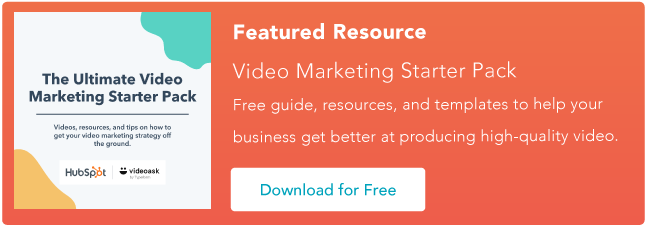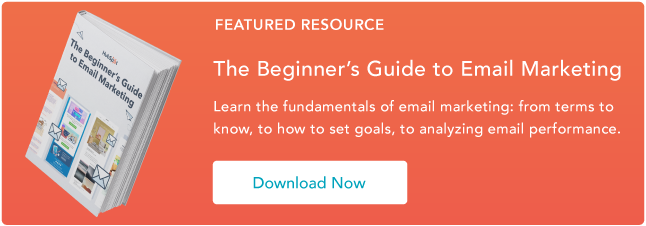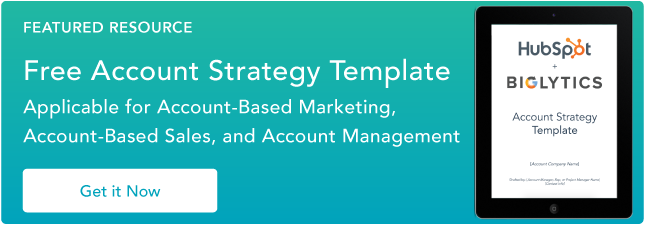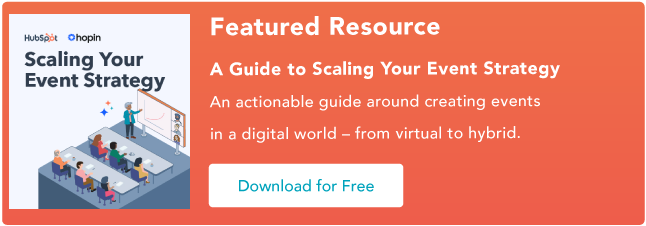Like many of the people who currently work in the industry, digital marketing was born in the 1990s. Since then, the industry has evolved at breakneck speed, sprouting many more types of marketing.
From search engine marketing to account-based marketing, every brand can use a combination of these tactics to attract its target audience and bring in more revenue.
Read on to learn about the top types of marketing around today.
Types of Marketing
1. Traditional Marketing
Traditional marketing refers to brand promotion on offline channels that were around before the rise of the internet. Think billboards, flyers, and radio spots.
Because information wasn't as easily accessible and readily available, the majority of traditional marketing relied on outbound tactics such as print, television ads, and billboards.
2. Outbound Marketing
Outbound marketing refers to intrusive promotion, such as cold calling, email blasts to purchased lists, and print ads.
This marketing method is called "outbound" because it involves pushing a message out to consumers to raise awareness on your products or services — regardless of consumer interest.
3. Inbound Marketing
Inbound marketing, on the other hand, is focused on attracting customers rather than interrupting them. The majority of inbound marketing tactics fall under digital marketing, as consumers are empowered to do research online as they progress through their own buyer's journey.
Inbound is built on three pillars: Attract, engage, and delight. Your initial goal is to create valuable content and experiences that resonate with your audience and attract them to your business.
The next is to engage them through conversational tools like email marketing and chat bots, and of course continued value. Finally, you delight them by continuing to act as an empathetic advisor and expert.
4. Digital Marketing
Digital marketing is the opposite of traditional marketing, leveraging technology that didn't exist traditionally to reach audiences in new ways. This type of marketing encompasses all marketing efforts that live online.
Businesses leverage digital channels, such as search engines, social media, email, and websites to connect with current and prospective customers.
5. Search Engine Marketing
Search engine marketing, or SEM, includes all strategies used to ensure your business is visible on search engine results pages (SERPs). With SEM, you can get your business in the number one spot when a user searches a particular keyword.
The two types of SEM are search engine optimization (SEO) for organic search results and pay-per-click (PPC) advertising for sponsored search engine results.
To get started with SEO, you must familiarize yourself with search engine ranking factors and produce content for search engines to index.
Pay-per-click SEM involves bidding on keywords to get your ads placed, through platforms like Google Ads. There are also ads management tools to make creating and managing PPC campaigns a breeze.
6. Content Marketing
Content marketing is a key instrument in inbound and digital marketing because it's one of the best ways to attract your target audiences.
It involves creating, publishing, and distributing content to your target audience through free and gated channels, such as social media platforms, blogs, videos, ebooks, and webinars.
With content marketing, the goal is to help your audience along their buyer's journey. First, identify common FAQs and concerns your buyers have before they are ready to make a purchase.
Then, create an editorial calendar to help you create and manage your content. It also helps to have a content management system (CMS) to make publishing easy.
7. Social Media Marketing
With platforms like Facebook, Instagram, LinkedIn, and Twitter, brands can promote their business and engage with audiences on a more personal basis.
However, with social media, two things are key to success: relevant content and consistency.
No one logs on to social media looking for something to purchase, it's important to balance promotion with entertainment. Compelling images and captions that encourage your audience to like, share and comment will bring your brand that much closer to gaining a customer.
Now onto consistency – it's what keeps your followers coming back. How can they get invested in your brand if they rarely see it on their timeline? To make publishing content across platforms easy, there are a number of social media tools that automate the process.
8. Video Marketing
According to a 2021 Wyzowl study, 87% of marketers say using video in their marketing strategy has a positive ROI. Whether it's for your website, YouTube channel, email list, and/or social media following, video can boost brand awareness, generate conversions, and close deals.
Some video marketing apps even allow you to analyze, nurture, and score leads based on their activity.
9. Voice Marketing
Voice marketing is leveraging smart speakers like Amazon Alexa and Google Home to add value to your audience and answer questions about their topics of interest.
Beyond optimizing your website for voice search by incorporating the right keywords, you can also get inventive by developing a Google Home action or Alexa skill.
For instance, Uber created an Alexa skill that allowed users to request a ride with a simple voice request. TED developed a feature that allowed Alexa users to play TED Talk based on topic, tone or speaker.
10. Email Marketing
Email marketing connects brands to leads, prospects and customers via email. Email campaigns can be used to increase brand awareness, generate traffic to other channels, promote products or services, or nurture leads toward a purchase.
Email regulations like the GDPR and the CAN-SPAM Act require brands to comply with responsible commercial email practices, which boil down to three principles:
- Only email people who are expecting to hear from you. I.e. they've opted in.
- Make it easy for subscribers to opt out.
- Be transparent about who you are when you do make contact.
With that in mind, the first thing you'll need to do is strategize how you'll build your email list — the database of contacts you can send emails to. The most common method is through lead capture forms on your website.
Then, you'll need email marketing software and a CRM to send, track, and monitor the effectiveness of your emails. To push your email strategy further and maximize productivity, you may also want to look into email automation software that sends emails based on triggering criteria.
To learn the ins and outs of email marketing, take the free email marketing course from HubSpot Academy.
11. Conversational Marketing
Conversational marketing is the ability to have 1:1 conversations with your audience across multiple channels – meeting customers how, when, and where they want. It is more than just live chat, it extends to phone calls, texts, Facebook Messenger, email, Slack, and other channels.
When you're getting started, you'll first identify which channels your audience is on. The challenge, though, is being able to manage multiple channels without slow response times, internal miscommunication, or productivity loss. That's why it's important to use conversational marketing tools , such as a unified inbox, to streamline your efforts.12. Buzz Marketing
Buzz marketing is a viral marketing strategy that leverages refreshingly creative content, interactive events, and community influencers to generate word-of-mouth marketing and anticipation for the product or service a brand is about to launch.
Buzz marketing works best when you reach out to influencers early and have a plan in place to generate buzz surrounding your brand. To track your efforts, invest in social listening software to keep a pulse on how your audience is responding.
13. Influencer Marketing
Influencer marketing is designed to tap into an existing community of engaged followers on social media. Influencers are considered experts in their niches and have built loyalty and trust from an audience you might be trying to reach.
To get started with influencer marketing, you must first build your influencer marketing strategy and define what type of influencer you're targeting. Then, you'll want to create criteria for your influencer to ensure they align with your strategy and budget. Factors to consider include their niche, the size of their audience, and their current metrics.
From there, you can find influencers and reach out to them by:
- Manually reaching out on social media.
- Using an influencer marketing platform.
- Hiring an agency to do the research and outreach for you.
14. Acquisition Marketing
With any marketing strategy, your goal is to attract and retain customers. However, each type of marketing focuses on a specific stage of the buyer's journey. Acquisition marketing focuses on the attract and convert phases to turn strangers into sales-qualified leads.
What differentiates it from other marketing types is that it extends beyond the marketing team, often involving collaboration with customer service and success teams. Why? Because satisfied customers are the biggest promoters.
Acquisition marketing can involve a number of tactics to turn a website into a lead generation engine, including offering freemium products, launching education hubs, tightening the copywriting on the site, conversion rate optimization, and lead optimization.
It may even include a lead optimization and nurturing strategy to facilitate the hand-off between marketing and sales.
15. Contextual Marketing
Contextual marketing is targeting online users with different ads on websites and social media networks based on their online browsing behavior. The number one way to make contextual marketing efforts powerful is through personalization.
A CRM combined with powerful marketing tools, such as smart CTAs can make a website seem more like a "choose your own adventure" story, allowing the user to find the right information and take the right actions more effectively.
Contextual marketing takes strategy and planning, so start off on the right foot by accessing HubSpot's free contextual marketing course.
16. Personalized Marketing
Personalized marketing aims to create a tailored marketing experience for every user who comes across your brand.
This can be as simple as adding a user's name in the subject line of an email or sending product recommendations based on past purchases. Software products like Versium Reach make it easy for marketers to target their B2B or B2C customers with powerful audience insights.
While it might seem a tad bit creepy, most consumers are OK with it if it makes for a better shopping experience. A 2019 Smarter HQ study reported that 79% of consumers felt brands knew too much about them. Yet, 90% of them were still willing to share information about their behavior and preferences for a cheaper, easier, and more enjoyable purchasing journey.
17. Brand Marketing
Brand marketing is shaping your brand's public perception and forging an emotional connection with your target audience through storytelling, creativity, humor, and inspiration.
The goal here is to be thought-provoking and generate discussion so that your brand is remembered and associated with positive sentiment.
To begin brand marketing, you need to deeply understand your buyer persona and what resonates with them. You must also consider your position in the market and what makes you unique from your competitors. This can help shape your values and what you stand for, giving you fodder for storytelling campaigns.
18. Stealth Marketing
Stealth marketing occurs when brands promote their products or service to consumers who don’t realize they’re being marketed to. For instance, when you’re watching a television show, and see a branded product integrated into the shot.
Before influencers were subject to ad disclosure regulations, they often used stealth marketing to advertise sponsored products.
For this marketing style to work, brands have to find opportunities that align with their brand identity and values.
19. Guerrilla Marketing
Guerrilla marketing is placing bold, clever brand activations in high-traffic physical locations to spread brand awareness.
Examples of guerilla marketing include altering outdoor urban environments, promoting during a live event without permission from sponsors or organizers, public stunts, and treasure hunts.
It can be a cost-effective way to garner widespread attention. However, it also has the potential to go left if its misunderstood by the audience or interrupted by weather conditions, law enforcement or other factors beyond the brand's control.
20. Native Marketing
Native marketing occurs when brands customize their ads to fit the feel, look, and function of the platform on which they'll be published.
Often, brands collaborate with publishers to create and distribute sponsored content to their audience. The goal is, by leveraging the brand's editorial expertise and creating non-disruptive ads, it will increase conversion rates or create some brand awareness.
For instance, a recipe blogger could have a guest post from McBride Sisters Collection titled "The Best Wine-Infused Desserts For the Holiday Season."
To benefit from native marketing, you'll need to either reach out to media publications yourself or go through a native advert network that helps find and facilitate ad placement.
21. Affiliate Marketing
When a business rewards another brand – called an affiliate or affiliate partner – with a commission for each purchase made by a customer through the affiliate's promotion tactics, that's affiliate marketing.
It's popular among influencers but can also be used by brands to promote products or services that align with their own.
If you already have marketing assets that are performing well, such as a website that generates leads or an engaged social media network, affiliate marketing is a great way to further leverage those assets. Choose a product or brand that closely aligns with what you sell – but does not compete with you – and promote it to your audience.
On the flip side, it's a cost-effective method of spreading brand awareness and a good alternative to influencer marketing. You can leverage affiliate marketing to generate more revenue. And the best part is that every business can design its own rules when launching an affiliate program.
22. Partner Marketing
Partner marketing, also known as co-marketing, is a marketing collaboration between brands where they partner up on a marketing campaign and share the results. It's a great lead generation tool that allows brands to tap into an audience they may not have reached yet.
For it to work, brands must align on their goals, have products or services that complementary and have similar user personas.
23. Product Marketing
Product marketing is much more than what it sounds like. It's not just taking product pictures and launching campaigns. It's driving demand for a product and its adoption through positioning, messaging, and market research.
Product marketers sit at the intersection between product, sales, marketing, and customer success teams. They work with all teams for sales enablement and aligned marketing strategies.
24. Account-based Marketing
Account-based marketing (ABM) is a hyper-focused marketing strategy where teams treat an individual prospect or customer like their very own market. Marketing teams create content, host events, and launch entire campaigns dedicated to the people associated with that account, rather than the industry as a whole.
This strategy allows brands to design personalized campaigns for their ideal clients and dedicate their time and resources to prospects exhibiting high-intent behaviors.
Here's how you can start:
- Identify key accounts.
- Create messaging based on issues that matter to them most
- Learn how to put that messaging in action with HubSpot's introductory ABM lesson.
Find ABM software that can enable your efforts.
25. Customer Marketing
In contrast to acquisition marketing where the focus is on acquiring new customers, customer marketing is focusing on retaining your existing customers. The end goal is to delight your customers with your product or service as well as excellent customer service to turn them into brand advocates.
The cost of acquisition is much higher than the cost to retain or upsell existing customers, so brands can benefit from investing in this type of marketing.
However, it does rely on constant improvement of the customer experience, i.e. the impression you leave with a customer after you've provided service.
Simple ways to do this include eliminating friction in the customer service process, providing self-service resources, like online knowledge bases, and using customer service software to manage and automate interactions.
26. Word-of-Mouth Marketing
Whose opinion do you trust more: Your friend's or a brand's? The answer is obvious.
That's why word-of-mouth marketing is so powerful. While you can't force it to happen, you can position your brand in a way that makes it easier to do so, like:
- Creating shareable, viral-worthy content.
- Offering referral and loyalty programs.
- Requesting reviews after providing a product or service.
27. Relationship Marketing
Relationship marketing is a type of customer marketing that focuses on cultivating deeper, more meaningful relationships with customers to ensure long-term brand loyalty.
It's not focused on short-term wins or sales transactions but rather on creating brand evangelists who will promote the brand.
The key to doing this is by focusing on delighting your customers who are already satisfied with your brand. Start by using customer feedback software to run a Net Promoter Score (NPS) campaign to help you find out who those customers are.
Then, come up with ways to turn those happy customers into raving fans. From there, you can request that they leave a testimonial, participate in a case study, or help you achieve your goals another way.
28. User-generated Marketing
User-generated marketing is when businesses leverage their audience to participate in creating marketing material.
It can be anything from a social media hashtag challenge that asks users to come up with a jingle, or asking users to share their pictures or videos using your product or service.
Why do brands use it? It's cost-effective, builds connection with your audience, and increases brand awareness.
29. Campus Marketing
Some brands target college students, and who better to market to them than their peers?
Campus marketing is the process of promoting products or services to students on campus. It often involves brand ambassadors who bring awareness to the business.
You'll often see campus marketers promoting products at event booths, hosting their own events, and handing out giveaways.
30. Proximity Marketing
Proximity marketing is a local and highly targeted marketing strategy that uses users' location to show them relevant product or service promotions.
For instance, if you're walking by an ice cream shop, you may receive a notification of a special discount for a flavor at that shop. There are a few ways to use proximity marketing:
- Bluetooth beacons
- Wi-Fi
- QR codes
- NFC
- Geofencing
Brands can also use it to organize treasure hunts, retarget users who don't make a purchase, or simply learn more about user behavior.
31. Event Marketing
You've got an event coming up to launch a new product. Now, how do you get your target audience to show up? That's event marketing.
It requires brands to plan a promotion strategy, develop creative assets to create anticipation, and determine the right channels to spread awareness.
An event – whether it's a workshop, seminar, trade show, conference, or pop-up shop – helps brands connect directly with their target audience and build lasting relationships.
32. Experiential Marketing
Experiential marketing encompasses in-person and virtual events, experiences, and interactions that forge lasting emotional connections between a brand and its target audience.
It takes event marketing just one step further with the goal of making the experience magical for attendees and providing something they can take with them after the event is over — other than just information, of course. According to independent HubSpot research, 61% of marketers surveyed said experiential marketing is one of the most effective strategies for their company.
At HubSpot, we do our best to make our INBOUND conference an immersive experience that extends beyond breakout sessions by including networking opportunities, parties and happy hours, food truck lunches, and other immersive experiences. Instead of a conference, INBOUND becomes a celebration.
33. Interactive Marketing
Interactive marketing is a trigger-based marketing strategy that creates a dialogue between a brand and its audience. The brand adapts its approach based on the user's behavior.
For instance, let's say you're on a bookstore website and searching for a memoir. The next time you log on, you may see recommendations for more memoirs from other authors. This strategy meets consumers where they're at and adjusts to meet their needs.
34. Global Marketing
Global marketing is the process of scaling your marketing efforts to appeal to global audiences. However, it does require lots of market research to determine where a product or service may best resonate and how to market it to reach business goals.
Take, for instance, a food company based in Germany. If the team decides to expand to the United States, there may be changes in menu items, packaging, pricing and advertising to better reflect the audience.
35. Multicultural Marketing
Multicultural marketing is devising and executing a marketing campaign that targets people of different ethnicities and cultures within a brand's overarching audience.
It involves in-depth research to understand those communities needs and values, and figuring out the right messaging to resonate with that group.
36. Informative Marketing
Informative marketing refers to the type of message that focuses more on the facts and less on emotions.
This marketing tactic highlights how your product's features and benefits solve your customers' problems and compares to your competitors.
37. Neuromarketing
Neuromarketing leverages neuroscience to gain insights into consumer decisions and predict behaviors.
Neuromarketing studies can involve tracking eye movements, analyzing brain scans, and tracking physiological functions in response to marketing stimuli.
38. Persuasive Marketing
Unlike informative marketing, persuasive marketing taps into users' emotions. It aims to make an audience feel something, associate those emotions with a brand, and trigger desired actions.
There are many techniques, including the scarcity principle or adding .99 to a price, that can aid in persuading consumers to purchase a product or service.
However, it only works if you understand your buyer persona and know what will resonate with your target audience.
39. Cause Marketing
With cause marketing, brands tie themselves to social issues while promoting their goods. For instance, your favorite brand may advertise that a purchase from their brand will result in a donation to a certain charity.
It can also go beyond a campaign. Some brands' entire identity aligns with a particular issue. For instance, luxury jewelry brand Civil donates 20% of its profits to underrepresented founders and entrepreneurs.
Whether it's temporary or long term, you must answer three questions before starting with cause marketing:
- What causes does my brand care most about?
- How can we leverage our position to support those causes?
- How can we tell my prospects and customers about our efforts and encourage them to get involved?
40. Controversial Marketing
Controversial marketing uses controversial topics to drive attention to marketing campaigns. It doesn't aim to polarize audiences, but rather grab their attention and spark discussions.
There are pros and cons to this approach. On one hand, it has the potential to go viral and generate some buzz around your brand. However, there's a risk that you turn off potential customers and negatively impact your brand's image.
41. Field Marketing
Field marketing, a.k.a field selling, is a traditional form of marketing that involves going out to promote your products or services directly to your target audience. You can do this by distributing product samples, offering product demos, or leafleting in a community.
Best Type of Marketing
There's no right or wrong way to do marketing — as long as it connects with your desired audience and provides a return on investment. Most companies use a combination of these strategies to generate leads and acquire customers.
Ultimately, you'll want to choose what makes the most sense for your business based on your product, audience, and resources.
C
41 Types of Marketing Your Brand Can Invest In was originally posted by Local Sign Company Irvine, Ca. https://goo.gl/4NmUQV https://goo.gl/bQ1zHR http://www.pearltrees.com/anaheimsigns












No comments:
Post a Comment